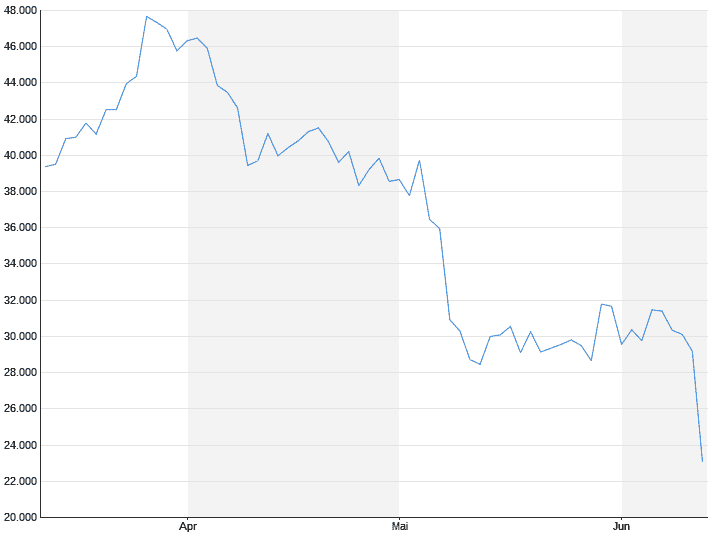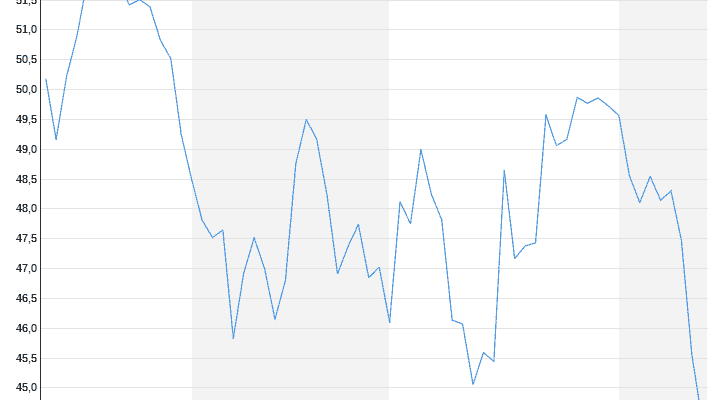Signs of recession are increasing
US stock exchanges gave way at the beginning of the week
06/13/2022, 11:23 p.m
On Wall Street, prices fall significantly at the start of the week. In addition to the Ukraine war and high inflation, the bond market is also showing signs of a possible recession. In addition to financial values, the prices of cryptocurrencies lost again, sometimes massively.
Investors are fleeing the US stock market on fears of a recession. The US blue chip index Dow Jones fell 2.79 percent on Monday to a one-and-a-half year low of 30,516.74 points. So was the broad-based S&P 500 and the tech-heavy Nasdaq, which slipped 3.88 percent to 3,749.63 points and 4.6 percent to 10,288.32 points, respectively.
Investors feared central banks will have to take more drastic measures to contain inflation, said Stuart Cole, chief economist at brokerage firm Equiti Capital. “Lower growth and an eventual recession are increasingly seen as the price for this.” This was reflected in a development on the bond market. There, at 3.26 percent, two-year government bonds yielded as much as they did more than 14 years ago and more than their ten-year counterparts. These returned at 3.155 percent. This phenomenon, called the inverted yield curve, is seen as a harbinger of a recession.
Half or three quarters of a percentage point?
Due to the ongoing price pressure, a rate hike of 0.75 percentage points in July is considered certain. Such a big step could also come on Wednesday, when the Fed discusses its monetary policy. Investors put the probability of this at 25 percent. They see a 75 percent chance that the increase will be half a percentage point, as signaled. This heaved the dollar index, which tracks rates against major currencies, temporarily fell 0.6 percent to a 19-1/2-year high of 105.07 points. Financial stocks, on the other hand, threw investors out of their portfolios. The shares of Bank of America, Citigroup or JPMorgan fell by up to 3.1 percent.
Commodities on the decline
The pessimists were also in the majority on the commodity markets. New lockdowns in parts of the Chinese capital Beijing fueled additional speculation that demand would fall. The US crude oil variety STI fell 0.2 percent to $120.87 per barrel (159 liters). The price of the industrial metal copper also fell one percent to $9,352 a ton. Because of the dollar strength, the gold less attractive for investors outside the USA, not even the “anti-crisis currency” could escape the downward trend and lost 2.2 percent to $1,830 per troy ounce (31.1 grams).

It went even steeper down for Bitcoin and Ethereum. With losses of up to 23 percent to $22,590 and a good 30 percent to $1165, the two cryptocurrencies are heading for their largest daily loss since the stock market crash in March 2020. In addition to recession fears, problems at the financial services provider Celsius, which specializes in cryptocurrency loans, made investors nervous. “Everything is collapsing in the crypto world and it’s only going to get worse,” said Neil Wilson, chief analyst at online brokerage Markets.com.
Crypto assets under massive pressure
Against this background, values from the cryptocurrency sector and companies dealing with the blockchain technology underlying Bitcoin & Co flew out of the depots. So the papers fell off Coinbase, Riot, Marathon and Silvergate up to 15 percent on Wall Street. The titles Microstrategy at times even fell by almost 30 percent, as sharply as it was 20 years ago. The software company has invested billions in Bitcoin. The same applies to the electric car manufacturer Teslawhose shares lost five percent.
